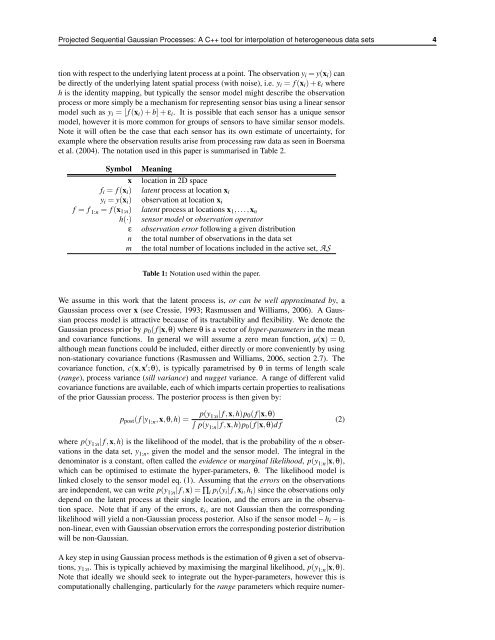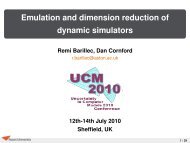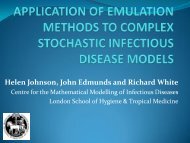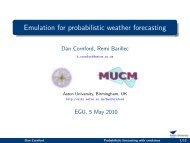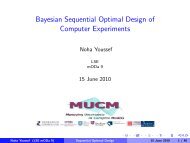Projected Sequential Gaussian Processes: A C++ tool for ... - MUCM
Projected Sequential Gaussian Processes: A C++ tool for ... - MUCM
Projected Sequential Gaussian Processes: A C++ tool for ... - MUCM
You also want an ePaper? Increase the reach of your titles
YUMPU automatically turns print PDFs into web optimized ePapers that Google loves.
<strong>Projected</strong> <strong>Sequential</strong> <strong>Gaussian</strong> <strong>Processes</strong>: A <strong>C++</strong> <strong>tool</strong> <strong>for</strong> interpolation of heterogeneous data sets 4<br />
tion with respect to the underlying latent process at a point. The observation yi = y(xi) can<br />
be directly of the underlying latent spatial process (with noise), i.e. yi = f (xi) + εi where<br />
h is the identity mapping, but typically the sensor model might describe the observation<br />
process or more simply be a mechanism <strong>for</strong> representing sensor bias using a linear sensor<br />
model such as yi = [ f (xi) + b] + εi. It is possible that each sensor has a unique sensor<br />
model, however it is more common <strong>for</strong> groups of sensors to have similar sensor models.<br />
Note it will often be the case that each sensor has its own estimate of uncertainty, <strong>for</strong><br />
example where the observation results arise from processing raw data as seen in Boersma<br />
et al. (2004). The notation used in this paper is summarised in Table 2.<br />
Symbol Meaning<br />
x location in 2D space<br />
fi = f (xi) latent process at location xi<br />
yi = y(xi) observation at location xi<br />
f = f 1:n = f (x1:n) latent process at locations x1,...,xn<br />
h(·) sensor model or observation operator<br />
ε observation error following a given distribution<br />
n the total number of observations in the data set<br />
m the total number of locations included in the active set, AS<br />
Table 1: Notation used within the paper.<br />
We assume in this work that the latent process is, or can be well approximated by, a<br />
<strong>Gaussian</strong> process over x (see Cressie, 1993; Rasmussen and Williams, 2006). A <strong>Gaussian</strong><br />
process model is attractive because of its tractability and flexibility. We denote the<br />
<strong>Gaussian</strong> process prior by p0( f |x,θ) where θ is a vector of hyper-parameters in the mean<br />
and covariance functions. In general we will assume a zero mean function, µ(x) = 0,<br />
although mean functions could be included, either directly or more conveniently by using<br />
non-stationary covariance functions (Rasmussen and Williams, 2006, section 2.7). The<br />
covariance function, c(x,x ′ ;θ), is typically parametrised by θ in terms of length scale<br />
(range), process variance (sill variance) and nugget variance. A range of different valid<br />
covariance functions are available, each of which imparts certain properties to realisations<br />
of the prior <strong>Gaussian</strong> process. The posterior process is then given by:<br />
ppost( f |y 1:n,x,θ,h) = p(y 1:n| f ,x,h)p0( f |x,θ)<br />
p(y1:n| f ,x,h)p0( f |x,θ)d f<br />
where p(y 1:n| f ,x,h) is the likelihood of the model, that is the probability of the n observations<br />
in the data set, y 1:n, given the model and the sensor model. The integral in the<br />
denominator is a constant, often called the evidence or marginal likelihood, p(y 1:n|x,θ),<br />
which can be optimised to estimate the hyper-parameters, θ. The likelihood model is<br />
linked closely to the sensor model eq. (1). Assuming that the errors on the observations<br />
are independent, we can write p(y 1:n| f ,x) = ∏i pi(yi| f ,xi,hi) since the observations only<br />
depend on the latent process at their single location, and the errors are in the observation<br />
space. Note that if any of the errors, εi, are not <strong>Gaussian</strong> then the corresponding<br />
likelihood will yield a non-<strong>Gaussian</strong> process posterior. Also if the sensor model – hi – is<br />
non-linear, even with <strong>Gaussian</strong> observation errors the corresponding posterior distribution<br />
will be non-<strong>Gaussian</strong>.<br />
A key step in using <strong>Gaussian</strong> process methods is the estimation of θ given a set of observations,<br />
y1:n. This is typically achieved by maximising the marginal likelihood, p(y 1:n|x,θ).<br />
Note that ideally we should seek to integrate out the hyper-parameters, however this is<br />
computationally challenging, particularly <strong>for</strong> the range parameters which require numer-<br />
(2)


